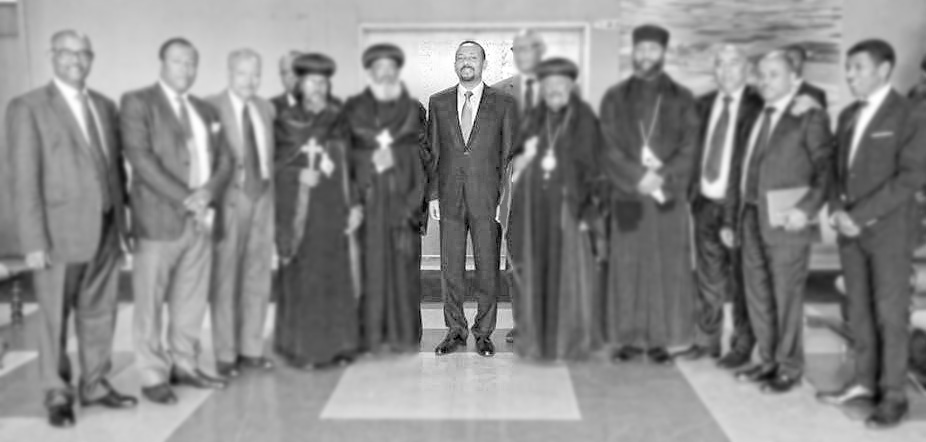The term clerical or clerico-facism was first used relative to Ethiopia by Italian opponents of Mussolini invasion of Ethiopia in 1935. Almost a century later clerico-fascism returns to describe Christian clergy in Ethiopia as well as diaspora in the United States and Europe who support completely the brutal invasion of Tigray by Abiy Ahmed.

Currently in Ethiopia, the Prime Minister Abiy Ahmed, son of a Christian mother and Muslim father, but now a Pentacostal Christian is being criticized as being a clerico-fascist by opponents to his regime. They see this clerico-facism as really Amharic elitism by another name.
In 1920s Italy, the rise of Benito Mussolini found support with the Partido Poplare Italiano who advocated a joining of fascism and Catholicism. At the time the Catholic Church world wide was deeply concerned with the threat of communism and socialism which advocated loyalty to state above all else. That religion was an antiquated system contrary to the state. The marriage of Catholicism to facism offered a clear path of survival to the church all though opponents saw it as heresy.
After being elevated to Prime Minister from being the head of the Oromo Regional political party he went on a tour of the United States in 2018. He was accompanied by Jawar Mohammed, a Muslim diaspora leader, who both advocated a national identity overriding regional nationality as well as cooperation between all religions including Orthodoxy, Protestant, Catholic, Muslim, and others.
Now three years later radical Christian voices have become not only the main defenders of his policy of oppression and non-negotiation with political opponents and Tigray but appear to be even writing his policies. To understand this further we have to back in time to review the religious history of Ethiopia. The Prime Ministers promise of medemer, mixing for the benefit of all Ethiopians, has been changed to the old theme of Amharic elitism.
Legend has it that the Saban Queen of Sheba met King Solomon of Israel producing a son, Menelik, who began what is known as the Solomonic dynasty of Ethiopia. The Axumite Empire based in what is now the Tigray Regional State and Eritrea of initially ruled by the ancestors to the Tigrayans but gradually the Amhara region who are also descended somewhat from this empire took over. For centuries there was a close relationship of the Ethiopian Orthodox Church (EOC) and the monarchy such that Ethiopian identity was tied to this religion for both Tigray and Amhara. Muslims came to Ethiopia to seek refuge during the Prophet Mohammed’s struggles with the pagan Saudi Arabian leaders and were welcomed. Today they make up a sizeable minority in the country as a whole but traditionally were marginalized by not be allowed to own land. There ability to construct mosques in areas of Ethiopia were always restricted.
The ancient EOC began in the Semitic Tigray and Amhara region but over the past approximately 200 years its dominance spread with conquering of Cushitic kingdoms in the western and southern regions of Ethiopia. The religion, Amharic language, and many cultural practices of the Northern regions were exported to the new conquests. In fact just before the beginning of the 20th century, the monarchal capital was shifted from Northern Ethiopia to Addis Ababa in the center of the country in what was Oromo territory. This was done to allow for the Amhara rulers to better defend and govern their larger territorial gains.
The EOC promoted the idea that the Semitic kings were chosen by God to rule over all of what we know call Ethiopia. The Bible they use was written in Geez a precursor to the current Amhara language and the official language of trade and government become Amhara. Additionally the EOC promoted the idea that the Oromo and Southern peoples were of an inferior nature to the Semitics of the North. This resulted in the EOC approving of land seizure, capture, and use of Southern and Western non-Semitic Cushitic’s to be used as slaves.
The Protestant conversions began in the Southern and Western regions by Western missionaries in the late 19th century and continuing today who told the people that they had equal status under God. Today the Protestant churches, mostly Pentecostal, are growing fast and have moved up from the Southern regions to central Ethiopia including the capital city of Addis Ababa. They have little presence in Tigray which has small groups of Catholics and Muslims.
When Abiy Ahmed toured the United States it excited both Amharic diaspora who were EOC and also the newer evangelical protestant. Pentecostals believe in the concept of Arminianism which clearly proclaims that salvation is rigidly defined by their specific definition and all others deserve suffering and hell completely. Other types of evangelical Christians believe in the Calvinistic idea that only a few are pre-chose by God even before birth for salvation and leading society. A tri-partite alliance of Pentecostals, evangelical Christians, and significant elements of the Amharic EOC has formed as stalwart advisors and defenders of the policy of aggression to only the Tigray but other minority groups in Ethiopia. In Ethiopia and other countries with large numbers of diaspora major divisions have arisen within the EOC.
Abiy Ahmed’s opponents say that he has under gone a transformation from calling for equality to one that really promotes Amhara elitism. As noted by many historians such as Professor Christopher Clapham who writes: “Although Ethiopia has continuously formed a multi-ethnic political system, participation in national political life normally required assimilation to the cultural value of the Amhara core: the Amharic language, orthodox Christianity and a capacity to operate within the structure and assumptions of a court administration.”

